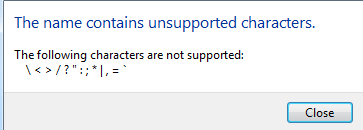

- #MICROSOFT WORD THIS IS NOT A VALID FILE NAME ERROR MESSAGE SOFTWARE#
- #MICROSOFT WORD THIS IS NOT A VALID FILE NAME ERROR MESSAGE CODE#
- #MICROSOFT WORD THIS IS NOT A VALID FILE NAME ERROR MESSAGE DOWNLOAD#
The filename itself was limited to 8 alphanumeric characters.
#MICROSOFT WORD THIS IS NOT A VALID FILE NAME ERROR MESSAGE SOFTWARE#
These extensions were created automatically and appended to the filename by the software that saved the file. A typical DOS screen image showing 8.3 filename stylesįilename extensions were always visible and took the form of “TXT” for a text file, or “DOC” for a Microsoft Word document, of “XLS” for an Excel spreadsheet, and so on. You were allowed up to 8 characters in the filename (letters and numbers only) followed by a period (full stop) followed by a 3 character filename extension that was used to identify the type of file you were saving. A Little History of Filenamesīack in the mists of time when the “MS-DOS command line” was king and a mouse was something undesirable that lurked behind the refrigerator, filenames were a simple affair. If you haven’t got time to read this entire article the main point is that it may be prudent to keep your filenames (and the names of folders in which they are stored) shorter, more succinct, and avoid using certain characters (spaces being one of them) if you wish to avoid problems. But lately, recent advances can mean that just a little more thought might be required when choosing a name for your files. Hopefully if you are still having this issue or it crops up in the future, you will have the chance to apply this fix and not struggle with MS’s lack of meaningful error messages 😛 thank you.We don’t often think about filenames now – the length of the name, or the characters that make up the name – but this wasn’t always the case. The error described is not the exact same message (similar…) but the real key is that this page was also linked from another MS KB that expanded on the reasons the “Fix It” was issued (here:, section “Hyperlinks from Office to Internet Explorer or to another Web browser”) and confirms your suspicion that the call to open the URL was not making it to the browser at all. also, this was not limited to MS WORD and EXCEL, but extended to Outlook and possibly to the entire Office suite (but this was not tested) like you describe, the problem URL linked to a protected page that requires a user logon, while hyperlinks to Google or other public pages opened fine. While searching i found very few fixes for it and the few that i found were ineffective. Hello! after struggling with this EXACT symptom of opening links in MS Office, thought i would share HOW IT WAS FIXED. The real problem was that Word and Excel provided less than meaningful error messages – if they had just forwarded the request to access the URL to a browser, we would have seen the meaningful error message from the website and worked out what was happening immediately. When I turned off the security to test it, the links in Word and Excel worked as expected.
#MICROSOFT WORD THIS IS NOT A VALID FILE NAME ERROR MESSAGE CODE#
The wp_die function I was calling returned a 404 HTTP code to the browser when it output the error message – which is all that Word or Excel could get from the site – thus they believed (correctly) that the URLs were (currently) invalid. I had set up a basic layer of security prior to site launch by including a conditional in the header template of the WordPress site which checked to see if the user was logged in to WordPress as an editor or administrator, and if not – display an error message explaining the site was coming soon. On closer inspection I found that web pages on the site I was developing were indeed returning 404 errors. If there is an error returned from the website for that URL, Word or Excel will refuse to load it. This proved to be a major clue to the problem – it seemed related to the website I was building rather than a problem in Word or anything else.Īfter a bit of Googling I found a technote that explained that the Office programs will attempt to access the link first before forwarding the URL to your browser to load the web page. I had them create some test links to other website and found that these worked without a problem.

Strangely enough, I got exactly the same error – which was very perplexing considering that the link itself was completely valid and worked in my browser.

I had them send me the spreadsheet and Word document – I don’t use Microsoft Office, but I do have the readers installed. They also tried doing it in Microsoft Word, but received a similar error.
#MICROSOFT WORD THIS IS NOT A VALID FILE NAME ERROR MESSAGE DOWNLOAD#
Cannot download the information you requested”. Whenever they clicked on a link in their spreadsheet, they received an error “Unable to open. They were creating content for their new website that I was in the process of building and wanted to include bookmarks to content they had already created on the site. A client called me asking for help with a problem on one of their Microsoft Excel spreadsheets.


 0 kommentar(er)
0 kommentar(er)
